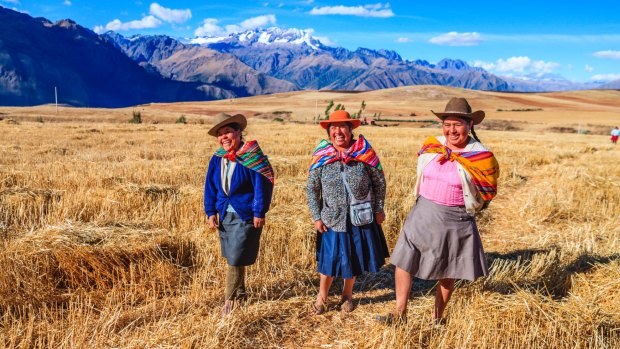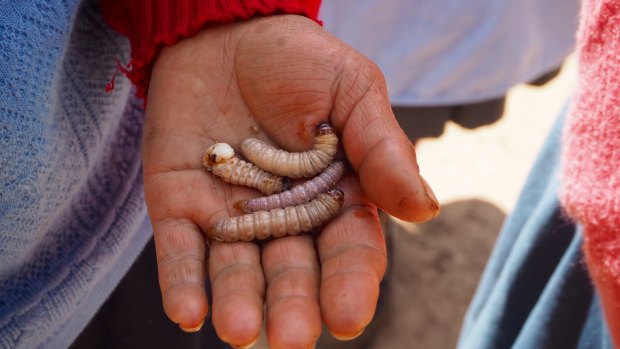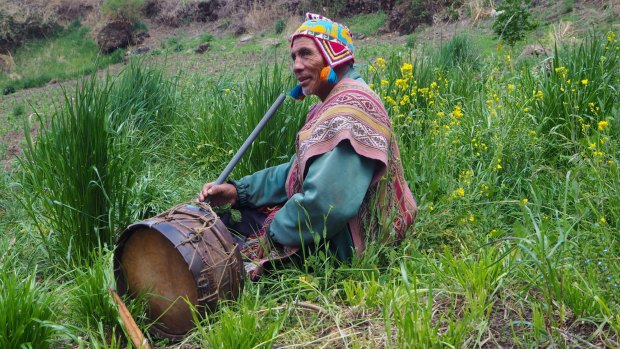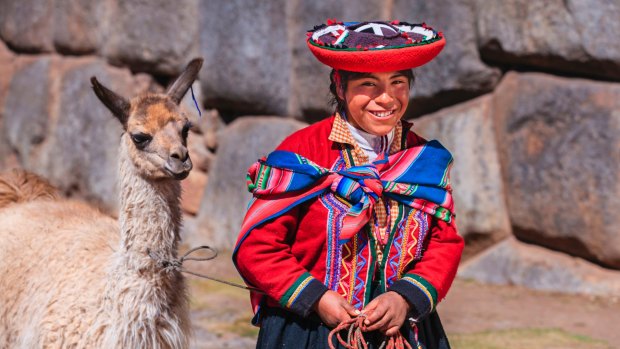This was published 7 years ago
Sacred Valley of Peru, South America travel guide: A magical journey high in the Andes

Plenty of mysteries in the Sacred Valley of the Incas.Credit: iStock
High in Peru's Sacred Valley, in a community called Huayllafara, I am discussing worm eating with a local farmer. Dropping his crude machete into the cactus-like Achupalla plant, he hacks the trunk open and picks out a handful of light-brown Suksakuro worms. He smiles as wide as the valley stretching below us and tells me, via my guide in the local Quechua language, that Would I like one? Pan-fried with a little oil, you can't beat them, he says.
Looking at the worms squirming around in his cupped hands, it seems hard to believe. But really, what was the point of flying across the other side of the world if I'm going to get squeamish about worms at the last moment? A few minutes later I'm lifting one from the plate. Closing my eyes, I pop it in my mouth and chew. It's squidgy, like calamari. And then, an unexpected revelation: Peruvian worms taste like mushrooms.
This is just one of many revelations here in this wind-swept valley slung between the peaks of the Andes mountain range. Just last night, when I awoke at midnight in my homestay in nearby Lamay village and reached out for some water, sparks crackled around my arm as it swept across the sheets. Worrying the altitude had gone to my head (we were at 3200 metres above sea level), I lifted the sheets and shuffled my legs around in the inky blackness. There they were again, tiny lightning bolts spider-webbing around my limbs. To me, it seemed like pure magic. But in the morning, when I excitedly asked my host family what it was all about, they simply shrugged their shoulders. It happens, don't know why, no big deal. In the Andean universe, where the locals believe gods called apus live in the mountains surrounding them, nature never seems to surprise. And nor, it seems, does magic.

The worms are not only nutritious but delicious, too.Credit: Nina Karnikowski
My journey through Peru's Sacred Valley, a one-hour drive from Cusco via a narrow road of hairpin turns, began the previous day. My guide Ara and I arrived in Patabamba, a community of about 800 people, to start a 14-kilometre hike that would take most of the day. Entering the front gate of one of the adobe-style village houses, we found ourselves in a small garden. Two women in spectacular flared skirts and red tea-cosy-like hats sprinkled petals on our heads and grabbed our hands for an awkward dance, as two men played a traditional welcome song on a patched-up drum and a flute made from old pipe. When the song finished, one of the women pulled out an embroidered piece of fabric and a small plastic bag of dried leaves, which she began tossing about like confetti.
"She's reading those coca leaves," Ara whispered to me, "to see if we'll have good luck on our hike."
The woman selected three of the fallen leaves, held them up to the sky and blew on them. An offering to the apus and to pachamama, or mother earth, explained Ara after chatting briefly with the woman in Quechua. "And now, you must take three leaves to chew. If they're sweet, it's a sign the trail will be good."

A welcome song was played on a patched-up drum and a flute.Credit: Nina Karnikowski
Coca leaves, the ones from which the drug cocaine is extracted, are good for avoiding altitude sickness, something we needed since we'd be hiking at 4000 metres. But they're also an integral part of ancient native rituals like these that are still a core aspect of Peruvian culture today. I took three leaves, stuffed them into the side of my mouth like Ara showed me, and started chewing. An intense bitterness immediately filled my mouth, so strong I needed to excuse myself to use the bathroom, where I quickly spat them out.
Pushing the portentous bitter coca leaves from my mind, we started off along dirt tracks leading through the fertile valley. As we walked, we passed children herding sheep through groves of rustling eucalyptus trees, villages of thatched-roof adobe houses where cactus and donkeys seemed to outnumber people, and terraced farmland growing potatoes, oats, barley and wheat. I huffed and puffed like a 95-year-old woman from the altitude, while Ara told me tales of the ancient Inca people and their masterful architecture, skilful farming methods, and profound respect for their natural resources.
"For the Inca, this valley was their food store, their chemist and their wardrobe," she said, pointing out the various herbs and grasses they used. The chilca plant for dyeing clothes; cinchona bark for treating stomach problems and increasing appetite; muna mint for its digestive and antiseptic qualities.

Peruvian girl wearing national clothing walking her llama.Credit: iStock
On we walked, through winding gorges filled with Achupalla plants and along original stone Inca roads, the valley below coming into view every so often. Its swirling shades of brown and mossy green were skirted by snow-capped summits, and divided by the clay-coloured river the Inca called Willkamayu, or Milky Way.
In the late afternoon we reached the archaeological remains of Huchuy Qosqo, meaning "Little Cusco" in Quechua, the place from which the 15th-century Inca royal estate ruled. We wandered through its impressive number of ochre-coloured stone buildings, meeting the odd sheep and alpaca as we went, and gushing over how its intricate irrigation systems and masterful masonry transformed the whole mountainside into a work of landscape art.
It wasn't until we'd descended into Lamay, and I was between the sheets with the lightning bolts, that I realised: we hadn't seen a single other traveller the entire day. Only the occasional local scurrying along the high-altitude paths, their bright outfits visible from a great distance, their presence in the immensity of the landscapes a reminder of our place in the order of things.
Speaking of the order of things, the next day I declined a second helping of those worms, despite not being averse to mushroom tasting things, and moved on to a hearty quinoa soup and chicken stew. I'm mostly vegetarian, but explaining that to a Peruvian is like telling a Frenchman you don't drink wine, so I didn't even try. I just smiled and nodded and, through Ara, tried to make chitchat. How hot is it today! Turns out worms aren't so bad! Do you think the rain will come soon? Blah, blah, blah.
The three farmers smiled but they looked bored. At least until the gourds of chicha, the homemade corn beer of the Andes, came out. It was a sign that it was time to get back into the fields. We headed outside and, after finishing the chicha and filling their mouths with the wads of coca leaves they first offered to the apus to make their farming successful, the three farmers and I got to work.
In the Sacred Valley, farmers work the fields with methods unchanged since the ancient Incan era, which are passed down through the generations. They never use machines, the farmer who'd given me the worms told me, only native wood and iron tools operated by hand or by animal. To sew corn we used a chaquitaclla, a foot plough that's basically a wooden pole with a huge knife strapped to the end with llama leather, to dig hole after hole after hole. When I say we, my job was to simply drop four dried corn kernels into said holes. Somehow, I still managed to end up lathered in sweat.
Soon we walked back to the farmers' adobe house, passing wild roses, passionfruit vines and strawberry patches. Before we said our farewells, we took some more fresh coca tea on a log bench in the shade. And just like that, in the bush of pink cantuta flowers (Peru's national flower, and sacred for the Incas) in front of us, two tiny hummingbirds emerged. Another sign, said Ara. But this time, a fortuitous one.
Looking at the birds, it was my turn to give thanks to the mountain spirits. For giving me an experience that had helped me understand the forgotten parts of Peru. And that had made me believe magic really might exist, after all.
FIVE OTHER SACRED VALLEY HIGHLIGHTS
1. PISAC MARKET
The traditional Andean village of Pisac runs a famous artisan market, selling goods gathered from the surrounding Quechua communities – everything from Andean pottery and technicolour weavings, to alpaca wool jumpers and elaborate jewellery. Every day 9am-4.30pm, with the largest market on Sunday.
2. OLLANTAYTAMBO RUINS
The site of the Inca's greatest military victory over the Spanish in 1536, Ollantaytambo offers stunning ancient stone walls and street grids that will give you a true feeling for how things might have been in the time of the Inca.
3. SALINAS DE MARAS
A beautiful, surreal landscape of more than 5000 terraced salt pans that has been used for salt extraction since the Incan civilisation. The ponds, fed by an underground stream, are owned by different local families.
4. CHINCHERO QUECHUA VILLAGE
Visit this typical Andean village, which the Incas believed was the birthplace of the rainbow, to see Inca ruins, sweeping views of snow-capped peaks, locals in traditional dress, and a pretty main plaza and 17th-century colonial church.
5. MORAY
One of Peru's best examples of Inca landscaping, with mysterious concentric circles of terraced farmland that looks like an ancient Greek amphitheatre. Temperatures at the top and bottom layers can vary by 20 degrees, leading researchers to believe the Inca used this as a type of agricultural research station.
TRIP NOTES
MORE
FLY
LATAM flies daily from Sydney and Melbourne to Cusco via Santiago and then Lima. See latam.com
TOUR
Crooked Compass's 11-day Wild Peru itinerary, which includes two nights in the Sacred Valley, is $5769 per person twin share. 2017 departures begin on April 30 and operate once a month in September and October. Crooked Compass also offers private tailor-made itineraries. See crooked-compass.com; 1300 855 790.
Nina Karnikowski travelled in Peru courtesy of Crooked Compass.
Sign up for the Traveller Deals newsletter
Get exclusive travel deals delivered straight to your inbox. Sign up now.